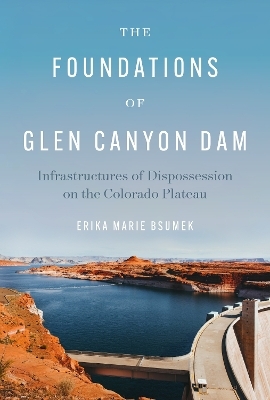
The Foundations of Glen Canyon Dam
University of Texas Press (Verlag)
978-1-4773-0381-8 (ISBN)
2024 Best Indigenous Studies Award, The Mormon History Association
2024 Southwest Book of the Year, Pima County Public Library
A history of how the construction of the Glen Canyon Dam was built and sustained by social inequalities
The second highest concrete-arch dam in the United States, Glen Canyon Dam was built to control the flow of the Colorado River throughout the Western United States. Completed in 1966, the dam continues to serve as a water storage facility for residents, industries, and agricultural use across the American West. The dam also generates hydroelectric power for residents in Colorado, Wyoming, New Mexico, Utah, Nevada, Arizona, and Nebraska. More than a massive piece of physical infrastructure and an engineering feat, the dam exposes the cultural structures and complex regional power relations that relied on Indigenous knowledge and labor while simultaneously dispossessing the Indigenous communities of their land and resources across the Colorado Plateau.
Erika Marie Bsumek reorients the story of the dam to reveal a pattern of Indigenous erasure by weaving together the stories of religious settlers and Indigenous peoples, engineers and biologists, and politicians and spiritual leaders. Infrastructures of dispossession teach us that we cannot tell the stories of religious colonization, scientific exploration, regional engineering, environmental transformation, or political deal-making as disconnected from Indigenous history. This book is a provocative and essential piece of modern history, particularly as water in the West becomes increasingly scarce and fights over access to it continue to unfold.
Erika Marie Bsumek is an associate professor of history at UT Austin. She is the author of the award-winning Indian-made: Navajo Culture in the Marketplace, 1848–1940 and the coeditor of Nation States and the Global Environment: New Approaches to International Environmental History.
Preface: Family Foundations
Introduction: The Many Foundations of Glen Canyon Dam
1. Religious Expansion: Latter-day Settlers, Dispossession, and Indentured Servitude, 1840–1880
2. Instruments of Dispossession: The Influence of Science and Scholarship, 1869–1920
3. Structures of Erasure: Engineering, Education, and Ecology, 1910–1960
4. Political Maneuvering: Reclamation and Termination in Diné Bikéyah, 1947–1980
5. Legal Paradigms and Dispossession: Navajos, Environmentalists, and the Law, 1969–1980
Epilogue: Dispossession and Possession: The Continued Fight over Sacred Land and Water on the Colorado Plateau
Acknowledgments
Notes
Bibliography
Illustration Credits
Index
| Erscheinungsdatum | 02.12.2022 |
|---|---|
| Zusatzinfo | 18 b&w photos, 8-page color insert |
| Verlagsort | Austin, TX |
| Sprache | englisch |
| Maße | 152 x 229 mm |
| Gewicht | 626 g |
| Themenwelt | Geisteswissenschaften ► Geschichte ► Regional- / Ländergeschichte |
| Geschichte ► Teilgebiete der Geschichte ► Kulturgeschichte | |
| Sozialwissenschaften ► Ethnologie | |
| Sozialwissenschaften ► Soziologie | |
| ISBN-10 | 1-4773-0381-2 / 1477303812 |
| ISBN-13 | 978-1-4773-0381-8 / 9781477303818 |
| Zustand | Neuware |
| Haben Sie eine Frage zum Produkt? |
aus dem Bereich


